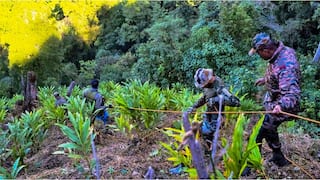'Floating Gold' Block Weighing 9.5 Kg Found In Dead Whale, Funds Raised Can Help La Palma Volcano Victims: Report
The block of ambergris is worth about €500,000. The University of Las Palmas hoping to sell the ambergris, so that the funds raised could be used to help the victims of the 2021 La Palma volcano.

A block of ambergris, also known as 'floating gold', has been found in the intestine of a dead sperm whale washed up along a shore in the Canary Island of La Palma. The block of ambergris weighs 9.5 kilograms, and is worth about €500,000, The Guardian reported. La Palma is an island in Spain, and a volcanic hotspot. In 2021, the devastating Cumbre Vieja volcanic eruption in La Palma caused a total damage of about 843 million euros.
According to a Guardian report, the University of Las Palmas is searching for a person who could buy the ambergris, so that the funds raised could be used to help the victims of the 2021 La Palma volcanic eruption.
Antonio Fernández Rodríguez, the head of the institute of animal health and food security at the University of Las Palmas, checked the whale's intestine because he suspected that the animal died due to a digestive problem, the report said. He felt something hard stuck to the colon, and said that on taking it out, he saw a stone of about 50-60 centimetres in diameter weighing 9.5 kilograms.
The ambergris caused sepsis inside the whale, leading to its death, Rodríguez said, according to the report.
Quoting him, the report said that the money collected after selling the ambergris to a potential buyer will go to the island of La Palma.
ALSO READ | Ancient Marine Predator, Once Thought To Be A Bone-Crusher, Probably Preferred Soft Prey: Study
All about ambergris
Ambergris is produced by sperm whales and is often described as one of the strangest natural occurrences in the world. It is a waxy, solid and inflammable substance produced in the intestines of the sperm whale, and is used in perfumes and medicines. Though ambergris, or whale vomit, has been used for centuries, its origin remained a mystery for many years.
Ambergris is formed when whales produce a fatty, cholesterol-rich substance, which acts as a defence and coats or surrounds the indigestible parts of the sperm whale’s prey, such as beaks and pens of squid and cuttlefish, according to Ambergris Connect, a UK firm that claims to connect buyers and sellers of genuine ambergris. The waxy substance allows the beaks to pass through the whale’s four stomachs without causing much damage to the intestinal walls, before expelling into the sea.
The indigestible elements are vomited out before digestion. In rare circumstances, these elements move into the whale’s intestines and bind together. Slowly, they become a solid mass of ambergris, growing inside the whale, according to an article by the National History Museum (NHM). Some people believe that the whale regurgitates its mass, and this is what earned ambergris its nickname — whale vomit.
Sperm whales produce ambrein only to glue together squid beaks. Ambergris starts as a mixture of squid beaks, ambrein, and another digestive product called epicoprostanol, the article said. It changes from a lump of poo into floating gold that has incorporated various smells of the ocean, according to an article by Prifysgol Bangor University.
Ambergris, which starts as a black lump, slowly bleaches. The ageing is believed to cause a reduction in the scent of faeces, which is water soluble and gradually lost, and is also responsible for the incorporation of the scents of the sea. The scents of the sea are fat-loving and absorbed by the waxy ambergris in the making.
Fossilised evidence of ambergris dates back to 1.75 million years. It is likely that humans have been using it for more than 1000 years. Ambergris has been called the “treasure of the sea”, and “floating gold”. It is called floating gold as it floats in the ocean after being expelled, and is one of the most sought after substances in the manufacture of perfumes.
Earlier, it was theorised that ambergris is hardened foam or the droppings of large birds. However, in the 1800s, the identity of the sole producer of ambergris was uncovered. The sperm whale (Physeter macrophalus) is the only living organism that produces Ambergris.
Richard Sabin, Curator of Marine Mammals at NHM, said that ambergris forms in the intestines and passes along with faecal matter, forming an obstruction in the rectum. Since sperm whales live all over the world, ambergris is expected to be found floating on any ocean. However, it is uncommon, and is found in less than 5 per cent of whale carcasses, he noted. Pygmy and Dwarf sperm whales are also thought to produce ambergris in smaller amounts.
Ambergris is very rare because not every sperm whale poo includes lumps. Also, the number of sperms are much lower these days.
The odour of ambergris is one of its clearest identifying traits. Whale vomit has been used in some expensive perfumes as it allows the scent to last longer. Amberin, an odourless alcohol, is believed to make a perfume’s scent last longer. On exposure to a certain type of activated oxygen, amberin creates fragrance compounds that are lighter and more volatile.






































